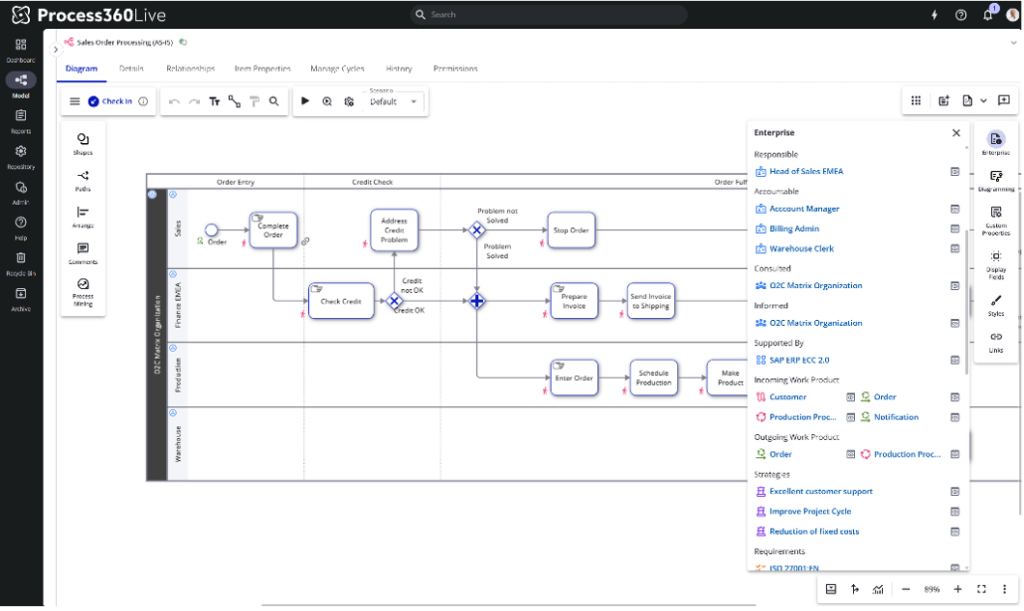Introduction: Why This Debate Matters Now
As someone who works daily with analysts, partners, and customers across industries, and keeps a close eye on vendor positioning, I’ve noticed a shift:
Process mining is still valuable — but it’s no longer seen as the solution for process transformation.
Some vendors now claim to offer full process intelligence because they’ve added modeling, simulation, or a repository to their mining platforms. But simply layering on features doesn’t make a platform model-aware — and that distinction matters more than ever for organizations navigating complexity, risk, and transformation at scale.
In this blog, I’ll break down the real differences between process mining and process intelligence, explore where they overlap, and explain why a model-aware approach is becoming essential — not just in regulated industries, but for anyone trying to improve how their business runs.
What Is Process Mining?
Process mining is a technique that uses system event logs to reconstruct how business processes actually run — uncovering bottlenecks, deviations, and inefficiencies.
It’s powerful because it gives you the truth of execution — not the ideal process someone thinks is happening, but what’s actually occurring based on data.
However, that truth has limits.
- It’s only as good as the systems it extracts logs from.
- It doesn’t capture manual steps, policy logic, or exceptions outside those systems.
- It shows what happened, but often misses why it happened — or how to fix it.
So, while process mining is a crucial discovery tool, it offers only a partial view of the business reality.
What Is Process Intelligence?
Process intelligence is a broader discipline. It combines process mining, task mining modeling, simulation, monitoring, and governance to deliver a holistic, continuous view of your business processes — from how they’re designed to how they behave in real time.
Where mining shows execution, process intelligence answers bigger questions:
- Are we operating according to policy?
- What’s likely to go wrong next?
- Can we safely make this change — and predict its impact before we do?
- How do we balance performance, risk, and compliance?
In short: process intelligence helps you not just see but understand — and improve.
Process Mining vs. Process Intelligence – Key Differences
| Capability | Process Mining | Process Intelligence |
| Source | System event logs | Models + Logs + Manual Inputs |
| Scope | ‘As-is’ visualization | Design, execution, simulation, governance |
| Context | System behavior | Business logic + policy + risk |
| Strength | Discovery | End-to-end transformation |
| Limitation | Misses non-digital steps | Broader but requires modeling discipline |
Where They Overlap — and Complement Each Other
This isn’t an either/or situation. Process mining and process intelligence are complementary — when done right.
- Mining enriches models with real-world data, helping validate assumptions and surface inefficiencies.
- Models provide structure and context for mining results, making them actionable and aligned with business intent.
- Combined, they enable simulation, scenario testing, and transformation — safely and continuously.
But here’s the catch: it only works when modeling isn’t an afterthought.
And that brings us to the real shift underway.
The Real Shift — From Mining-Led to Model-Aware Intelligence
Some vendors are now retrofitting simulation, modeling, and repositories into their mining platforms — and calling it “process intelligence.”
But if those features are built around logs, rather than around models, the result is still mining-led.
Model-aware intelligence is different. It starts with the assumption that business processes aren’t just what the system shows — they’re what the business designs, governs, and is accountable for.
That matters when:
- You need to prove compliance, not just observe inefficiencies
- You want to simulate changes before taking action
- You’re managing transformation across departments, geographies, or regulatory environments
Most mining-led platforms also lack the ability to manage process interdependencies. Their repositories, if they exist, are often collections of mined flows — not governed models enriched with relationships, ownership (RACI), risks, policies, business strategies, or incoming/outgoing work products. These contextual elements are essential for managing change and making decisions that align with business goals — not just system behavior. They show isolated process paths based on data but rarely capture how processes connect, cascade, or depend on one another.
In contrast, model-aware solutions provide a structured process repository where every process is linked to others, versioned, and assigned ownership — enabling true impact analysis, change simulation, and cross-functional governance.
With over 25 years of modeling and governance experience, the iGrafx platform was built for this reality — long before process mining entered the scene.
Example from a model-aware process platform:
This Order-to-Cash (O2C) process is more than a diagram — it’s linked to ownership (RACI), risks, policies, work products, and business strategies. These relationships provide the context and control needed for transformation at scale.
Why Model-Aware Intelligence Benefits Everyone
While model-aware platforms have long served regulated industries like healthcare, banking, and insurance, the need for visibility, governance, and safe experimentation is now universal.
Whether you’re optimizing manufacturing capacity, digitizing customer journeys, or reducing operational risk, you need more than execution data — you need context, structure, and foresight.
Mining tells you what’s broken.
Model-aware intelligence helps you fix it — and predict what happens next.
A model-aware approach brings structure and context to every process: who owns it, what it supports, what it impacts, what risks are involved, and what it’s measured by. That kind of intelligence isn’t captured in logs — it’s embedded in the way processes are modeled, governed, and connected across the organization.
Conclusion: Making the Right Investment
Process mining isn’t dead. It’s matured. It’s a critical component of a larger, smarter approach.
But as transformation initiatives grow in complexity — and pressure to deliver ROI increases — organizations must look beyond tools that simply observe.
The future belongs to platforms that can model, monitor, and optimize processes intelligently — grounded in both data and design.
Curious to learn more about process intelligence? Contact iGrafx or book a personalized demo today.


